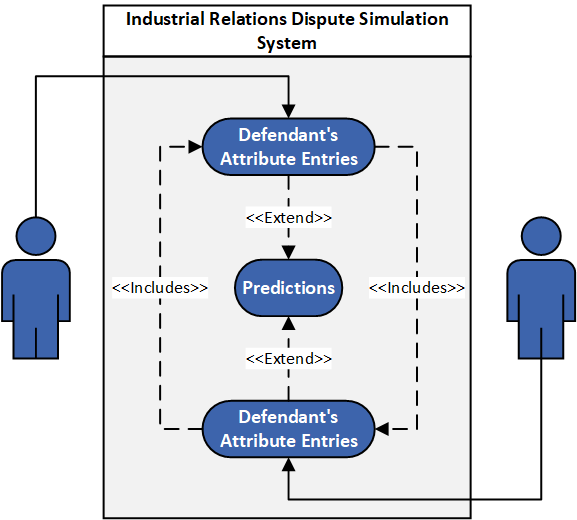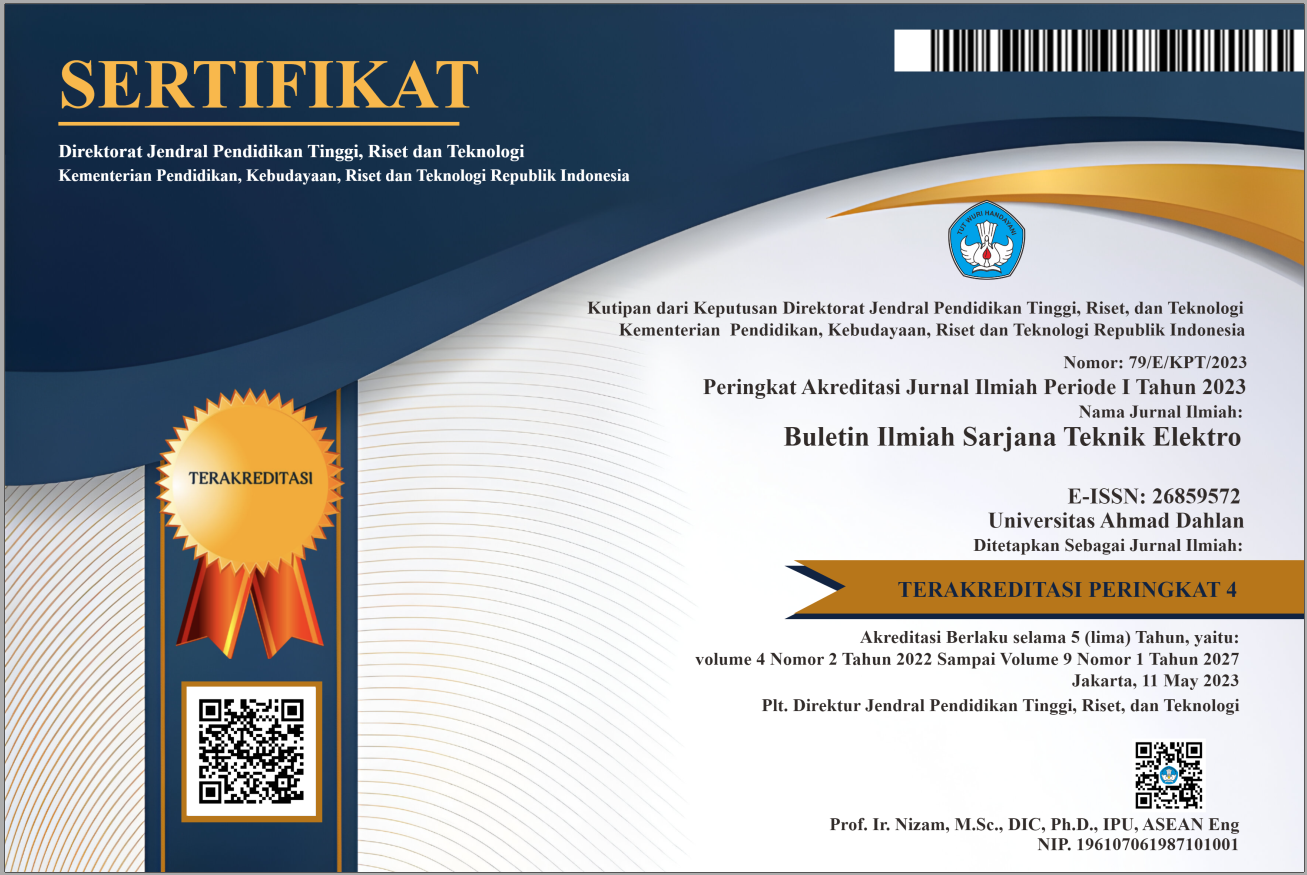Industrial Relations Dispute Simulation System Prototype with Artificial Intelligence Approach
DOI:
https://doi.org/10.12928/biste.v5i2.7607Keywords:
IRD, AI, Judicial, Decision Tree, AccuracyAbstract
There are many cases of industrial relations disputes/IRD every year. IRD cases can be resolved by kinship or mediation to reduce the material burden of all parties, such as case costs other than time and energy. With this background, the researcher proposed developing a system for simulating the IRD judicial process with an AI approach. AI encourages faster and high-accuracy prediction results because AI works through the learning process against a set of training data to produce learning models. The research method used is an experimental laboratory to select AI algorithms with the highest accuracy. Meanwhile, for system development methods, research proposes prototyping methods with designing systems using UML. Prototyping is an option because it takes the intensity of communication between the developer and the end user to determine the prototype of the system being built. System development with platform website. UML provides a variety of diagrams that facilitate communication with developers to illustrate the system being built. System testing uses the black box methodology approach because at this stage, testing is carried out to ensure that the functional system has met the needs. From the experimental results, the decision tree algorithm provides the highest accuracy of 80% in training and testing a set of datasets in the form of cases and IRD court rulings from 2022. The accuracy score means that the learning model by the decision tree algorithm can correctly predict (TP / True positive) 75 % of all cases (test data). The accuracy score is obtained through a confusion matrix that shows the performance of the decision tree algorithm for classification. The results of this research help the process of simulating IRD cases before being taken to judicial line to minimize costs and other efforts that could potentially be incurred during judicial process.
References
H. Matnuh, "Rectifying Consumer Protection Law and Establishing of a Consumer Court in Indonesia," Journal of Consumer Policy, vol.44, no. 3, pp.483-495, 2021, https://doi.org/10.1007/s10603-021-09487-z.
S. Skylaki, A. Oskooei, O. Bari, N. Herger and Z. Kriegman, "Legal Entity Extraction using a Pointer Generator Network," 2021 International Conference on Data Mining Workshops (ICDMW), pp. 653-658, 2021, https://doi.org/10.1109/ICDMW53433.2021.00086.
J. H. Nord, A. Koohang, and J. Paliszkiewicz, “The Internet of Things: Review and theoretical framework,” Expert Systems with Applications, vol. 133, pp. 97–108, 2019, https://doi.org/10.1016/j.eswa.2019.05.014.
Y. Ding, Y. Ding, Y. Li, and L. Cheng, “Application of Internet of Things and Virtual Reality Technology in College Physical Education,” IEEE Access, vol. 8, pp. 96065–96074, 2020, https://doi.org/10.1109/ACCESS.2020.2992283.
H. Bhatt, R. Bahuguna, R. Singh, A. Gehlot, S. V. Akram, N. Priyadarshi and B. Twala, "Artificial Intelligence and Robotics Led Technological Tremors: A Seismic Shift towards Digitizing the Legal Ecosystem. Applied Sciences, vol. 12, no. 22, p. 11687, 2022, https://doi.org/10.3390/app122211687.
K. Hyden, “AI, Norms, Big Data, and the Law•,” Asian J. Law Soc., vol. 7, no. 3, pp. 409–436, 2020, https://doi.org/10.1017/als.2020.36.
P. M. Nowotko, “AI in judicial application of law and the right to a court,” Procedia Comput. Sci., vol. 192, pp. 2220–2228, 2021, https://doi.org/10.1016/j.procs.2021.08.235.
S. Lanagan and K. R. Choo, “Forensic Science International : Digital Investigation On the need for AI to triage encrypted data containers in U . S . law enforcement applications,” Forensic Sci. Int. Digit. Investig., vol. 38, p. 301217, 2021, https://doi.org/10.1016/j.fsidi.2021.301217.
A. Koshiyama, E. Kazim and P. Treleaven, "Algorithm Auditing: Managing the Legal, Ethical, and Technological Risks of Artificial Intelligence, Machine Learning, and Associated Algorithms," in Computer, vol. 55, no. 4, pp. 40-50, 2022, https://doi.org/10.1109/MC.2021.3067225.
R. Vaishya, M. Javaid, I. H. Khan, and A. Haleem, “Artificial Intelligence (AI) applications for COVID-19 pandemic,” Diabetes Metab. Syndr. Clin. Res. Rev., vol. 14, no. 4, pp. 337–339, 2020, https://doi.org/10.1016/j.dsx.2020.04.012.
L. Chen, P. Chen, and Z. Lin, “Artificial Intelligence in Education: A Review,” IEEE Access, vol. 8, pp. 75264–75278, 2020, https://doi.org/10.1109/ACCESS.2020.2988510.
R. Cioffi, M. Travaglioni, G. Piscitelli, A. Petrillo, and F. De Felice, “Artificial intelligence and machine learning applications in smart production: Progress, trends, and directions,” Sustain., vol. 12, no. 2, 2020, https://doi.org/10.3390/su12020492.
J. S. Mora-Sanguinetti and M. Martínez-Matute, An economic analysis of court fees: evidence from the Spanish civil jurisdiction, vol. 47, no. 3, 2019, https://doi.org/10.1007/s10657-019-09614-9.
B. Zeller and L. Trakman, “Mediation and arbitration: The process of enforcement,” Unif. Law Rev., vol. 24, no. 2, pp. 449–466, 2019, https://doi.org/10.1093/ulr/unz020.
S. Permana, T. Subarsyah, and E. Firdatunnisa, “Implementation of Article 87 Law Number 2 of 2004 Concerning Resolution of Industrial Relations in the Court of Industrial Relations in Article of the Republic of Indonesia,” Int. J. Sci. Soc., vol. 2, no. 3, pp. 198–211, 2020, https://doi.org/10.54783/ijsoc.v2i3.155.
M. Haenlein and A. Kaplan, “A brief history of artificial intelligence: On the past, present, and future of artificial intelligence,” Calif. Manage. Rev., vol. 61, no. 4, pp. 5–14, 2019, https://doi.org/10.1177/0008125619864925.
O. Loyola-González, "Black-Box vs. White-Box: Understanding Their Advantages and Weaknesses From a Practical Point of View," in IEEE Access, vol. 7, pp. 154096-154113, 2019, https://doi.org/10.1109/ACCESS.2019.2949286.
A. Granić and N. Marangunić, “Technology acceptance model in educational context: A systematic literature review,” Br. J. Educ. Technol., vol. 50, no. 5, pp. 2572–2593, 2019, https://doi.org/10.1111/bjet.12864.
K. Mittal, A. Jain, K. S. Vaisla, O. Castillo, and J. Kacprzyk, “A comprehensive review on type 2 fuzzy logic applications: Past, present and future,” Eng. Appl. Artif. Intell., vol. 95, no. December 2018, p. 103916, 2020, https://doi.org/10.1016/j.engappai.2020.103916.
C. K. H. Lee, “A review of applications of genetic algorithms in operations management,” Eng. Appl. Artif. Intell., vol. 76, no. May, pp. 1–12, 2018, https://doi.org/10.1016/j.engappai.2018.08.011.
G. Teles, J. J. P. C. Rodrigues, R. A. L. Rabê, and S. A. Kozlov, “Artificial neural network and Bayesian network models for credit risk prediction,” J. Artif. Intell. Syst., vol. 2, no. 1, pp. 118–132, 2020, https://doi.org/10.33969/AIS.2020.21008.
B. Charbuty and A. Abdulazeez, “Classification Based on Decision Tree Algorithm for Machine Learning,” J. Appl. Sci. Technol. Trends, vol. 2, no. 01, pp. 20–28, 2021, https://doi.org/10.38094/jastt20165.
F. J. Yang, “An implementation of naive bayes classifier,” Proc. - 2018 Int. Conf. Comput. Sci. Comput. Intell. CSCI 2018, pp. 301–306, 2018, https://doi.org/10.1109/CSCI46756.2018.00065.
A. Bablani, D. R. Edla, D. Tripathi, S. Dodia and S. Chintala, "A Synergistic Concealed Information Test With Novel Approach for EEG Channel Selection and SVM Parameter Optimization," in IEEE Transactions on Information Forensics and Security, vol. 14, no. 11, pp. 3057-3068, 2019, https://doi.org/10.1109/TIFS.2019.2913798.
H. K. Kondaveeti, N. K. Kumaravelu, S. D. Vanambathina, S. E. Mathe, and S. Vappangi, “A systematic literature review on prototyping with Arduino: Applications, challenges, advantages, and limitations,” Comput. Sci. Rev., vol. 40, p. 100364, 2021, https://doi.org/10.1016/j.cosrev.2021.100364.
G. Gurung, R. Shah, and D. P. Jaiswal, “Software Development Life Cycle Models-A Comparative Study,” Int. J. Sci. Res. Comput. Sci. Eng. Inf. Technol. , no. March, pp. 30–37, 2020, https://doi.org/10.32628/CSEIT206410.
L. Gong, Å. Fast-Berglund and B. Johansson, "A Framework for Extended Reality System Development in Manufacturing," in IEEE Access, vol. 9, pp. 24796-24813, 2021, https://doi.org/10.1109/ACCESS.2021.3056752.
S. Ahmad, M. Z. Asghar, F. M. Alotaibi, and Y. D. Al-Otaibi, “A hybrid CNN + BILSTM deep learning-based DSS for efficient prediction of judicial case decisions,” Expert Syst. Appl., vol. 209, no. May 2021, p. 118318, 2022, https://doi.org/10.1016/j.eswa.2022.118318.
D. Alghazzawi, O. Bamasag, A. Albeshri, I. Sana, H. Ullah, and M. Z. Asghar, “Efficient Prediction of Court Judgments Using an LSTM+CNN Neural Network Model with an Optimal Feature Set,” Mathematics, vol. 10, no. 5, 2022, https://doi.org/10.3390/math10050683.
R. A. Shaikh, T. P. Sahu, and V. Anand, “Predicting Outcomes of Legal Cases based on Legal Factors using Classifiers,” Procedia Comput. Sci., vol. 167, no. 2019, pp. 2393–2402, 2020, https://doi.org/10.1016/j.procs.2020.03.292.
F. de Arriba-Pérez, S. García-Méndez, F. J. González-Castaño, and J. González-González, “Explainable machine learning multi-label classification of Spanish legal judgements,” J. King Saud Univ. - Comput. Inf. Sci., vol. 34, no. 10, pp. 10180–10192, 2022, https://doi.org/10.1016/j.jksuci.2022.10.015.
M. N. Arifin and D. Siahaan, “Structural and Semantic Similarity Measurement of UML Use Case Diagram,” Lontar Komput. J. Ilm. Teknol. Inf., vol. 11, no. 2, p. 88, 2020, https://doi.org/10.24843/LKJITI.2020.v11.i02.p03.
C. L. Al-qallaf and A. Ridha, “A Comprehensive Analysis of Academic Library Websites : Design , Navigation , Content , Services , and Web 2 . 0 Tools A Comprehensive Analysis of Academic Library Websites : Design , Navigation ,” Int. Inf. Libr. Rev., vol. 0, no. 0, pp. 1–14, 2018, https://doi.org/10.1080/10572317.2018.1467166.
A. S. Aydiner, E. Tatoglu, E. Bayraktar, and S. Zaim, “Information system capabilities and firm performance: Opening the black box through decision-making performance and business-process performance,” Int. J. Inf. Manage., vol. 47, no. December 2018, pp. 168–182, 2019, https://doi.org/10.1016/j.ijinfomgt.2018.12.015.
S. Sengupta and V. Dave, “Predicting applicable law sections from judicial case reports using legislative text analysis with machine learning,” J. Comput. Soc. Sci., vol. 5, no. 1, pp. 503–516, 2022, https://doi.org/10.1007/s42001-021-00135-7.
R. Sil, A. Roy, B. Bhushan and A. K. Mazumdar, "Artificial Intelligence and Machine Learning based Legal Application: The State-of-the-Art and Future Research Trends," 2019 International Conference on Computing, Communication, and Intelligent Systems (ICCCIS), pp. 57-62, 2019, https://doi.org/10.1109/ICCCIS48478.2019.8974479.

Published
How to Cite
Issue
Section
License
Copyright (c) 2023 Ridha Sefina Samosir, Naik Henokh Parmenas

This work is licensed under a Creative Commons Attribution-ShareAlike 4.0 International License.
Authors who publish with this journal agree to the following terms:
- Authors retain copyright and grant the journal right of first publication with the work simultaneously licensed under a Creative Commons Attribution License that allows others to share the work with an acknowledgment of the work's authorship and initial publication in this journal.
- Authors are able to enter into separate, additional contractual arrangements for the non-exclusive distribution of the journal's published version of the work (e.g., post it to an institutional repository or publish it in a book), with an acknowledgment of its initial publication in this journal.
- Authors are permitted and encouraged to post their work online (e.g., in institutional repositories or on their website) prior to and during the submission process, as it can lead to productive exchanges, as well as earlier and greater citation of published work (See The Effect of Open Access).
This journal is licensed under a Creative Commons Attribution-ShareAlike 4.0 International License.


